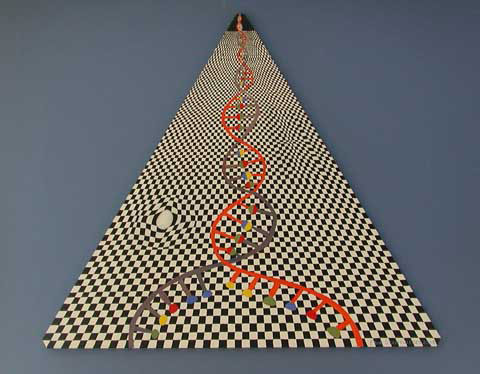2005 10 26
From: forbes.com

"Endless DNA" by Erik Streitwieser
Put your data on a hard drive, and it may be safe for a decade--assuming the drive doesn't break. But what if you want to keep information safe for hundreds of millions of years?
You might try DNA.
The power of DNA as a storage device was first recognized only six years after the molecule was discovered. In a prescient 1959 lecture at the California Institute of Technology, Richard Feynman, one of the most admired physicists of the 20th century, forecast that miniaturized technology would likely change the world--essentially predicting the digital revolution. Then he pointed out that nature had already done the microchip one better in the form of deoxyribonucleic acid.
In a small bundle of atoms at the center of every cell, Feynman noted, all the information needed to create a human, an amoeba or a tomato was encoded. As in so much else, Feynman was ahead of his time. Scientists have calculated that DNA may be the ideal storage medium. A mere pound of DNA could hold all the data that has ever been saved on any computer.
But harnessing that computational power has turned out to be tough. The first working computer made entirely of DNA was created in 1994 by Leonard Adleman, a computer scientist at the University of Southern California. In a teaspoon of water, he used a series of biochemical reactions to solve the famous “traveling salesman” problem (basically, how many ways can you get from New York to Cleveland while stopping in seven other cities in between?). The promise of the approach was that because each piece of DNA can function essentially as its own computer, it might be possible to use it to do as many as a quadrillion computations at once.
Unfortunately, pulling that trick off turns out to be easier said than done. Adleman himself has managed to solve a 20-variable problem with a DNA computer. But many researchers who flooded into the field of DNA computing after Adleman’s initial paper have now moved on to building tiny machines out of DNA molecules instead. The problem: Accessing all the information in a molecule of DNA turns out to be very cumbersome.
“My own personal conclusion is that the DNA computing paradigm isn't going to provide a powerful computing platform for solving problems,” says Lloyd Smith, a scientist at the University of Wisconsin-Madison who has done DNA computing work, but intends not to renew his grant applications related to the topic. “It's cute, but I don't know that it's an important concept.”
Some researchers who have stuck with the idea of storing information in DNA are actually moving away from the idea that the molecule can save massive amounts of information. Instead, they are focusing on saving smaller messages for long periods of time--perhaps outlasting all of the books, hard drives and backup tapes that civilization has produced.
DNA in organisms is constantly evolving, but error-correcting machinery keeps messages from degrading over time. Pak Chung Wong, a researcher at Pacific National Laboratories, points out that some strains of bacteria have kept their DNA pretty much intact for millions of years. He and his colleagues have developed a technique for implanting as many as 100 words into an organism’s genome and marking it off so that the message is protected against errors.
Wong and his colleagues showed that they could implant a message (they used lyrics from “It’s A Small World After All”) into the genome of bacteria. A whole family of bacteria with the message can be created, and even after hundreds of generations, the message was still intact. Wong notes that it would be possible to send a message to the future in a particularly hardy organism--such as a bacteria or a cockroach, that would survive a nuclear war. More practically, companies that create genetically modified organisms could use the technology to create a kind of DNA watermark to keep their intellectual property from being stolen.
Beyond providing a way for Genentech or Monsanto to keep other companies from stealing their genetically engineered organisms, such a technology could be the best way we have of sending a message to the distant future. Forget the engravings on the Voyager satellites. This message could last as long as there is any life on earth. The only question: what would we say?
Two audio clips available at original: here
Article from: http://www.forbes.com/2005/10/21/
genetics-dna-computing-comm05-cx_mh_1024herper.html
Related: Gregg Braden - The God Code: The Secret of Our Past, The Promise of Our Future
DeoxyriboNucleic Acid (DNA)
Are there alien messages in our DNA strands?
Designed by aliens?
Happiness And Optimism 'Can Change Your DNA'
